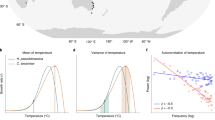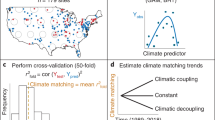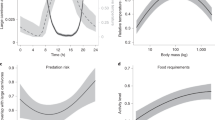Abstract
How climate affects biotic interactions is a question of urgent concern1,2,3. Theory predicts that biotic interactions are stronger at lower latitudes4,5,6. However, the role of climate in governing these patterns is typically assumed, rather than explicitly tested. Here, we dissected the influence of climatic descriptors on predation pressure using data from a global experiment with model caterpillars. We then used projections of future climate change to predict shifts in predation pressure. Climate, particularly components of temperature, explained latitudinal and elevational patterns of predation better than latitude or elevation by themselves. Projected predation pressure was greater under higher temperatures and more stable climates. Increased climatic instability projected for the near future predicts a general decrease in predation pressure over time. By identifying the current climatic drivers of global patterns in a key biotic interaction, we show how shifts in these drivers could alter the functioning of terrestrial ecosystems and their associated services.
This is a preview of subscription content, access via your institution
Access options
Access Nature and 54 other Nature Portfolio journals
Get Nature+, our best-value online-access subscription
$29.99 / 30 days
cancel any time
Subscribe to this journal
Receive 12 print issues and online access
$209.00 per year
only $17.42 per issue
Buy this article
- Purchase on Springer Link
- Instant access to full article PDF
Prices may be subject to local taxes which are calculated during checkout




Similar content being viewed by others
Data availability
The data that support the findings of this study are publicly available in the Dryad Digital Repository at https://doi.org/10.5061/dryad.j432q.
References
Tylianakis, J. M. et al. Global change and species interactions in terrestrial ecosystems. Ecol. Lett. 11, 1351–1363 (2008).
Blois, J. L. et al. Climate change and the past, present, and future of biotic interactions. Science 341, 499–504 (2013).
Urban, M. C. et al. Improving the forecast for biodiversity under climate change. Science 353, aad8466 (2016).
Dobzhansky, T. Evolution in the tropics. Am. Sci. 38, 209–221 (1950).
Schemske, D. W. in Speciation and Patterns of Diversity (eds Butlin, R. K., Bridle, J. R. & Schluter, D.) 219–239 (Cambridge Univ. Press, Cambridge, 2009).
Schemske, D. W. et al. Is there a latitudinal gradient in the importance of biotic interactions? Annu. Rev. Ecol. Evol. Syst. 40, 245–269 (2009).
IPCC Climate Change 2014: Synthesis Report (eds Core Writing Team, Pachauri, R. K. & Meyer, L. A.) (IPCC, 2014).
Allan, R. & Soden, B. Atmospheric warming and the amplification of precipitation extremes. Science 321, 1481–1484 (2008).
Fischer, E. M. & Knutti, R. Anthropogenic contribution to global occurrence of heavy-precipitation and high-temperature extremes. Nat. Clim. Change 5, 560–564 (2015).
Sala, O. E. et al. Global biodiversity scenarios for the year 2100. Science 287, 1770–1774 (2000).
Callaway, R. M. et al. Positive interactions among alpine plants increase with stress. Nature 417, 844–847 (2002).
Romero, G. Q. et al. Ecosystem engineering effects on species diversity across ecosystems: a meta-analysis. Biol. Rev. 90, 877–890 (2015).
LaManna, J. A. et al. Plant diversity increases with the strength of negative density dependence at the global scale. Science 356, 1389–1392 (2017).
Roslin, T. et al. Higher predation risk for insect prey at low latitudes and elevations. Science 356, 742–744 (2017).
Moles, A. T. & Ollerton, J. Is the notion that species interactions are stronger and more specialized in the tropics a zombie idea? Biotropica 48, 141–145 (2016).
Romero, G. Q. et al. Food web structure shaped by habitat size and climate across a latitudinal gradient. Ecology 97, 2705–2715 (2016).
Reynolds, P. L. et al. Latitude, temperature and habitat complexity predict predation pressure in eelgrass beds across the Northern Hemisphere. Ecology 99, 29–35 (2018).
Jiang, M. et al. Biome-specific climatic space defined by temperature and precipitation predictability. Glob. Ecol. Biogeogr. 26, 1270–1282 (2017).
Körner, C. The use of ‘altitude’ in ecological research. Trends Ecol. Evol. 22, 569–574 (2007).
Hawkins, B. A. & Diniz-Filho, J. A. F. ‘Latitude’ and geographic patterns in species richness. Ecography 27, 268–272 (2004).
Anstett, D. N. et al. Sources of controversy surrounding latitudinal patterns in herbivory and defense. Trends Ecol. Evol. 31, 789–802 (2016).
Brown, J. H. et al. Towards a metabolic theory of ecology. Ecology 85, 1771–1789 (2004).
Rosenblatt, A. E. & Schmitz, O. J. Climate change, nutrition, and bottom-up and top-down food web processes. Trends Ecol. Evol. 31, 965–975 (2016).
Gilbert, B. et al. A bioenergetic framework for the temperature dependence of trophic interactions. Ecol. Lett. 17, 902–914 (2014).
Vasseur, D. A. et al. Increased temperature variation poses a greater risk to species than climate warming. Proc. R. Soc. B 281, 20132612 (2014).
Wheeler, T. & von Braun, J. Climate change impacts on global food security. Science 341, 508–513 (2013).
Chen, I.-C. et al. Rapid range shifts of species associated with high levels of climate warming. Science 333, 1024–1026 (2011).
Cahill, A. E. et al. How does climate change cause extinction? Proc. R. Soc. Lond. B 280, 20121890 (2013).
Pecl, G. T. et al. Biodiversity redistribution under climate change: impacts on ecosystems and human well-being. Science 355, eaai9214 (2017).
Marino, N. A. C., Romero, G. Q. & Farjalla, V. F. Geographical and experimental contexts modulate the effect of warming on top‐down control: a meta‐analysis. Ecol. Lett. 21, 455–466 (2018).
Roslin, T. et al. Dryad Data from: Higher predation risk for insect prey at low latitudes and elevations. (Dryad Digital Repository, 2017); https://doi.org/10.5061/dryad.j432q
Fick, S. E. & Hijmans, R. J. WorldClim 2: new 1-km spatial resolution climate surfaces for global land areas. Int. J. Climatol. 37, 4302–4315 (2017).
Title, P. O. & Bemmels, J. B. ENVIREM: an expanded set of bioclimatic and topographic variables increases flexibility and improves performance of ecological niche modeling. Ecography 41, 291–307 (2017).
Morueta-Holme, N. et al. Habitat area and climate stability determine geographical variation in plant species range sizes. Ecol. Lett. 16, 1446–1454 (2013).
Wilson, M. F. J. et al. Multiscale terrain analysis of multibeam bathymetry data for habitat mapping on the continental slope. Mar. Geodesy 30, 3–35 (2007).
Conrad, O. et al. System for automated geoscientific analyses (SAGA) v. 2.1.4. Geosci. Model Dev. 8, 1991–2007 (2015).
Lefcheck, J. S. piecewiseSEM: piecewise structural equation modelling in R for ecology, evolution, and systematics. Methods Ecol. Evol. 7, 573–579 (2016).
Grace, J. B. et al. On the specification of structural equation models for ecological systems. Ecol. Monogr. 80, 67–87 (2010).
Peres-Neto, P. R. & Jackson, D. A. How well do multivariate data sets match? The advantages of a Procrustean superimposition approach over the Mantel test. Oecologia 129, 169–178 (2001).
R Development Core Team R: A Language and Environment for Statistical Computing (R Foundation for Statistical Computing, 2017).
Wiens, J. A. et al. Niches, models, and climate change: assessing the assumptions and uncertainties. Proc. Natl Acad. Sci. USA 106, 19729–19736 (2009).
Peterson, A. T. et al. Ecological Niches and Geographic Distributions (Princeton Univ. Press, Princeton, 2011).
Soberón, J. & Nakamura, M. Niches and distributional areas: concepts, methods and assumptions. Proc. Natl Acad. Sci. USA 106, 19644–19650 (2009).
Rahbek, C. et al. Predicting continental-scale patterns of bird species richness with spatially explicit models. Proc. R. Soc. B 274, 165–174 (2007).
Araújo, M. B. & New, M. Ensemble forecasting of species distributions. Trends Ecol. Evol. 22, 42–47 (2007).
Diniz-Filho, J. A. F. et al. Partitioning and mapping uncertainties in ensembles of forecasts of species turnover under climate change. Ecography 32, 897–906 (2009).
Nix, H. in Snakes: Atlas of Elapid Snakes of Australia (ed. Longmore, R.) 4–10 (Bureau of Flora and Fauna, Canberra, 1986).
Carpenter, G. et al. DOMAIN: a flexible modeling procedure for mapping potential distributions of animals and plants. Biodiv. Conserv. 2, 667–680 (1993).
Farber, O. & Kadmon, R. Assessment of alternative approaches for bioclimatic modeling with special emphasis on the Mahalanobis distance. Ecol. Model. 160, 115–130 (2003).
Phillips, S. J. & Dudik, M. Modeling of species distributions with MaxEnt: new extensions and a comprehensive evaluation. Ecography 31, 161–175 (2008).
Tax, D. M. J. & Duin, R. P. W. Support vector data description. Mach. Learn. 54, 45–66 (2004).
Liu, C. et al. On the selection of thresholds for predicting species occurrence with presence-only data. Ecol. Evol. 6, 337–348 (2016).
Allouche, O. et al. Assessing the accuracy of species distribution models: prevalence, kappa and the true skill statistic (TSS). J. Appl. Ecol. 43, 1223–1232 (2006).
Fielding, A. H. & Bell, J. F. A review of methods for the assessment of prediction errors in conservation presence/absence models. Environ. Conserv. 24, 38–49 (1997).
Sobral-Souza, T. et al. Biogeography of neotropical rainforests: past connections between Amazon and Atlantic forest detected by ecological niche modeling. Evol. Ecol. 29, 643–655 (2015).
Acknowledgements
We are most grateful to all authors of Roslin et al.14; without their contributions, this study would not have been possible. G.Q.R. was supported by BPE-FAPESP (grant no. 2016/01209-9) and CNPq-Brazil research grants. T.S.-S. was supported by a CNPq fellowship (grant no. 151003/2018-1). We gratefully acknowledge funding from the Academy of Finland (grant nos 138346, 276909, 285803 to T.R.). This work was performed during GQR’s sabbatical stay at Queen Mary University of London. This paper is a contribution of the Brazilian Network on Global Climate Change Research funded by CNPq (grant no. 550022/2014-7) and FINEP (grant no. 01.13.0353.00).
Author information
Authors and Affiliations
Contributions
G.Q.R. conceived the idea, developed it with all co-authors, and drafted the manuscript with inputs from all co-authors. G.Q.R., T.G.-S. and N.A.C.M. performed the statistical analyses. T.S.-S. performed the niche modelling with inputs from T.G.-S. and G.Q.R. T.G.-S. and T.S.-S. drafted the figures. All authors contributed substantially to revisions and the final format of the manuscript.
Corresponding author
Ethics declarations
Competing interests
The authors declare no competing interests.
Additional information
Publisher’s note: Springer Nature remains neutral with regard to jurisdictional claims in published maps and institutional affiliations.
Supplementary information
Supplementary Information
Supplementary Tables 1–3, Supplementary Figures 1–11
Rights and permissions
About this article
Cite this article
Romero, G.Q., Gonçalves-Souza, T., Kratina, P. et al. Global predation pressure redistribution under future climate change. Nature Clim Change 8, 1087–1091 (2018). https://doi.org/10.1038/s41558-018-0347-y
Received:
Accepted:
Published:
Issue Date:
DOI: https://doi.org/10.1038/s41558-018-0347-y
This article is cited by
-
Climate change increases predation risk for a keystone species of the boreal forest
Nature Climate Change (2020)
-
Warming drives ecological community changes linked to host-associated microbiome dysbiosis
Nature Climate Change (2020)
-
Biological control agent attack timing and population variability, but not density, best explain target weed density across an environmental gradient
Scientific Reports (2020)
-
Lipid metabolism in Calanus finmarchicus is sensitive to variations in predation risk and food availability
Scientific Reports (2020)
-
Wetland plant community variation across replicate urban to rural gradients: non-native species as both drivers and passengers in systems impacted by anthropogenic land-use
Urban Ecosystems (2020)



